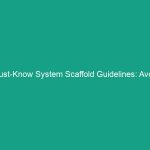Introduction
In today’s fast-paced world, the significance of Health, Safety, and Environment (HSE) practices cannot be overstated, especially in the realm of Traffic Safety and Vehicle Operations. The workplace, regardless of its nature, poses various risks, and when it involves vehicle operations, these risks can have severe consequences. Understanding and implementing robust traffic Safety Measures is crucial for protecting employees, reducing liability, and fostering a culture of Safety. This article delves into the essential guidelines surrounding traffic safety and vehicle operations, providing valuable insights into regulatory frameworks, best practices, real-life case studies, challenges faced, and future trends in this critical area.
Regulatory Frameworks
When it comes to Traffic Safety and Vehicle Operations, several regulatory frameworks govern how organizations should operate. These Regulations are designed to ensure the safety of all road users and can vary significantly from one jurisdiction to another.
1. International Regulations
Many countries adhere to international Standards set by organizations such as the United Nations Economic Commission for Europe (UNECE) and the World Health Organization (WHO). These organizations provide guidelines on vehicle safety and traffic management that member states are encouraged to implement. For instance, the UNECE has developed protocols that address vehicle emissions, safety features, and crash testing.
2. National Regulations
Each country typically has its own national regulations governing traffic safety. In the United States, for instance, the Federal Motor Carrier Safety Administration (FMCSA) establishes regulations for commercial vehicle operations, focusing on aspects such as driver qualifications, vehicle Maintenance, and operational practices. Companies must familiarize themselves with these regulations to ensure compliance and minimize risks associated with Traffic Safety and Vehicle Operations.
3. Local Regulations
At a local level, municipalities and states may impose additional regulations to address specific safety concerns pertinent to their regions. These regulations can include speed limits, zoning laws, and specific traffic Control Measures. Organizations must stay informed about these regulations and adapt their operations accordingly to promote safety and compliance.
Best Practices for Traffic Safety
Implementing Best Practices is vital for enhancing Traffic Safety and Vehicle Operations. Organizations can significantly reduce the risk of accidents and injuries by establishing clear safety protocols and promoting a culture of accountability.
1. Comprehensive Training Programs
One of the most effective ways to promote traffic safety is through comprehensive training programs for all employees involved in vehicle operations. Training should cover safe driving techniques, the importance of wearing seat belts, and the risks associated with distractions such as mobile phone use. Regular refresher courses can help reinforce safe habits and keep safety at the forefront of employees’ minds.
2. Regular Vehicle Maintenance
Ensuring that vehicles are well maintained is a critical component of traffic safety. Regular inspections and maintenance checks can identify potential issues before they lead to accidents. Organizations should establish a routine maintenance schedule that includes checking tire pressure, brakes, lights, and fluid levels. This proactive approach not only enhances safety but can also prolong the lifespan of vehicles.
3. Implementation of Safety Equipment
Equipping vehicles with safety technology can significantly improve traffic safety outcomes. Features such as anti-lock braking systems (ABS), electronic stability control (ESC), and rearview cameras can assist drivers in avoiding accidents. Furthermore, implementing telematics systems allows organizations to monitor driving behavior and vehicle performance, providing insights that can lead to improved safety practices.
4. Establishing Clear Policies
Organizations should develop clear traffic safety policies that outline expectations for employees operating vehicles. These policies might include guidelines on speed limits, use of mobile devices while driving, and Procedures for reporting accidents. A well-communicated policy can help create a culture of safety and accountability among employees.
5. Encouraging Open Communication
Encouraging open communication about traffic safety can lead to improved practices and a safer environment. Organizations should create channels for employees to report safety concerns or near-miss incidents without fear of repercussions. By analyzing these reports, organizations can identify patterns and implement changes to prevent future accidents.
Case Studies on Effective Traffic Safety Implementation
Learning from real-world examples can provide valuable insights into effective traffic safety and vehicle operations. Here are some notable case studies that illustrate the impact of robust safety practices.
1. Company A: Reducing Accidents through Training
Company A, a logistics firm, faced a high rate of vehicle accidents involving its delivery drivers. To address this issue, the company implemented a comprehensive training program focusing on defensive driving and hazard recognition. After one year, the company reported a 30% reduction in accidents, demonstrating the effectiveness of targeted training in enhancing Traffic Safety and Vehicle Operations.
2. Company B: Leveraging Technology for Safety
Company B, a transportation service provider, adopted telematics technology to monitor driver behavior and vehicle performance. By analyzing data on speeding, harsh braking, and idling, the company was able to identify high-risk driving patterns and provide targeted coaching to drivers. Over six months, this initiative led to a 25% decrease in speeding incidents and a significant reduction in fuel consumption, showcasing how technology can enhance safety and operational efficiency.
3. Company C: Establishing a Culture of Safety
Company C, a construction firm, recognized that fostering a culture of safety was essential for improving traffic safety among its vehicle operators. The company initiated a safety committee comprised of employees from various departments who met monthly to discuss safety concerns and propose solutions. This collaborative approach resulted in the implementation of new safety protocols and a 40% reduction in vehicle-related incidents within a year.
Challenges in Traffic Safety and Vehicle Operations
While significant progress has been made in enhancing traffic safety, several challenges remain. Addressing these challenges is crucial for fostering a safer environment for all road users.
1. Distracted Driving
Distracted driving continues to be a leading cause of traffic accidents. With the proliferation of smartphones, employees may be tempted to use their devices while driving, leading to dangerous situations. Organizations must implement strict policies prohibiting phone use while driving and provide education on the risks associated with distractions.
2. Fatigue Management
Driver fatigue is another significant risk factor in traffic safety. Long hours on the road can lead to decreased alertness and increased likelihood of accidents. Organizations should establish guidelines that promote adequate rest periods and consider implementing a fatigue management program to monitor driver hours and ensure compliance with regulations.
3. Evolving Technology
The rapid evolution of technology presents both opportunities and challenges for traffic safety. While advancements such as autonomous vehicles and advanced driver-assistance systems (ADAS) hold promise for improving safety, they also require ongoing training and adaptation for drivers. Organizations must stay informed about technological developments and their implications for traffic safety and vehicle operations.
4. Regulatory Compliance
Staying compliant with an ever-changing landscape of regulations can be daunting for organizations. Failure to comply can result in significant penalties and increased liability. To mitigate this risk, organizations should assign dedicated personnel to monitor regulatory changes and ensure that all traffic safety policies align with current laws.
Future Trends in Traffic Safety and Vehicle Operations
As we look to the future, several trends are likely to shape the landscape of Traffic Safety and Vehicle Operations. Staying ahead of these trends can help organizations enhance their safety practices and adapt to evolving challenges.
1. Increased Use of Technology
The integration of technology into vehicle operations is set to increase, with tools such as artificial intelligence (AI) playing a more prominent role in traffic safety. AI can analyze vast amounts of data to identify patterns and predict potential accidents, allowing organizations to proactively address safety concerns. Additionally, advancements in vehicle-to-everything (V2X) communication will enable vehicles to communicate with each other and infrastructure, further enhancing situational awareness and safety.
2. Emphasis on Mental Health
As awareness of mental health issues grows, organizations are beginning to recognize the impact of mental well-being on driving performance. Future traffic safety initiatives may include mental health support programs for drivers, helping to address issues such as stress, anxiety, and depression that can impair focus and decision-making on the road.
3. Focus on Sustainability
Sustainability will play an increasingly important role in traffic safety and vehicle operations. As organizations seek to reduce their carbon footprint, they may adopt electric or hybrid vehicles, which not only contribute to environmental goals but can also enhance safety through advanced features. The integration of sustainable practices into traffic safety initiatives will be crucial for future success.
4. Enhanced Training Methods
Future training programs for traffic safety are likely to become more interactive and engaging, utilizing virtual reality (VR) and augmented reality (AR) technologies. These immersive training experiences can provide drivers with realistic scenarios, allowing them to practice decision-making skills in a safe environment. Such innovations can enhance retention and application of safety knowledge in real-world situations.
Conclusion
In conclusion, understanding and implementing effective guidelines for Traffic Safety and Vehicle Operations is paramount for organizations aiming to promote a safe workplace. By adhering to regulatory frameworks, embracing Best Practices, learning from case studies, addressing challenges, and staying informed about future trends, organizations can significantly enhance their traffic safety outcomes. Investing in safety is not only a legal obligation but also a moral responsibility that Benefits employees, reduces liability, and fosters a culture of safety. As we move forward, let us prioritize traffic safety and continue to strive for a safer environment for all road users. Take action today by reviewing your current policies, investing in employee training, and fostering open communication about safety concerns.


